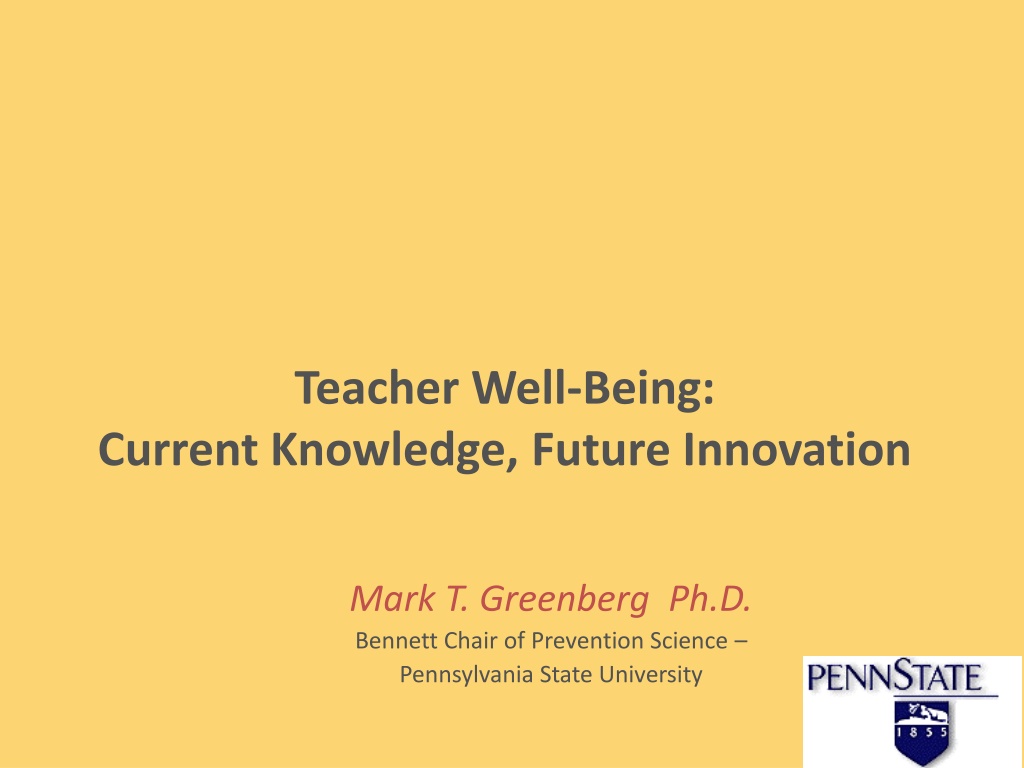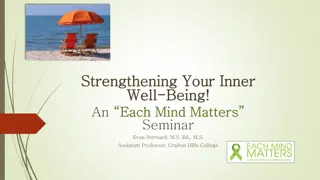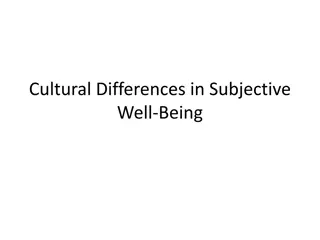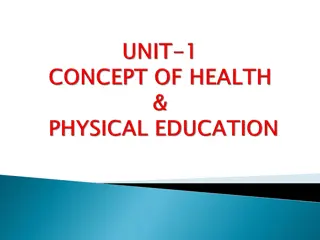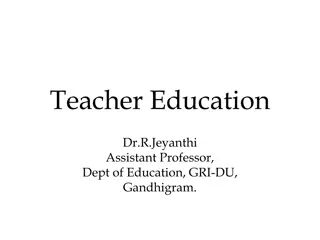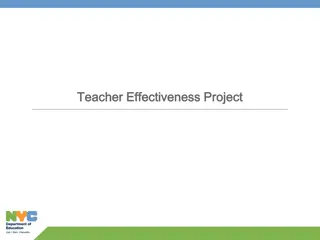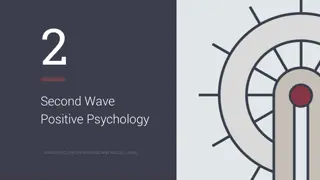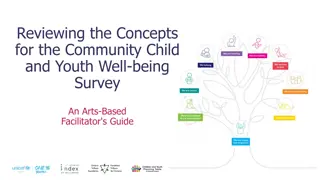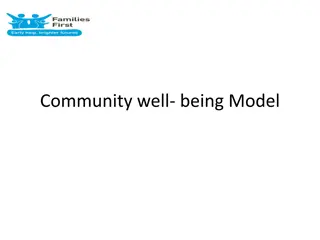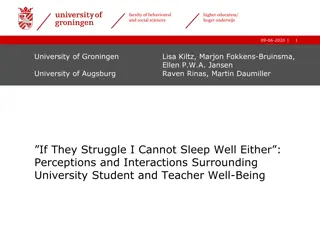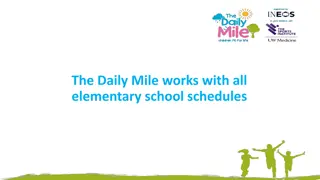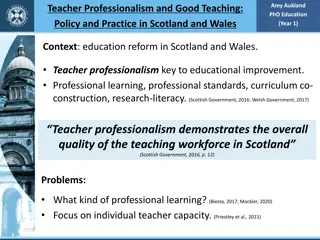Understanding Teacher Well-Being: Challenges and Solutions
Dive into the current landscape of teacher well-being, exploring trends in satisfaction, burnout, and attrition. Discover the causes and consequences of teacher stress, along with promising approaches for enhancing teacher well-being. Uncover the pressing need for innovation in supporting educators.
Download Presentation

Please find below an Image/Link to download the presentation.
The content on the website is provided AS IS for your information and personal use only. It may not be sold, licensed, or shared on other websites without obtaining consent from the author. Download presentation by click this link. If you encounter any issues during the download, it is possible that the publisher has removed the file from their server.
E N D
Presentation Transcript
Teacher Well-Being: Current Knowledge, Future Innovation Mark T. Greenberg Ph.D. Bennett Chair of Prevention Science Pennsylvania State University
What I Will Discuss Trends in Teacher Satisfaction, Burnout, Attrition Why These Trends Are Occurring? Sources of Teacher Stress Impacts of Teacher Stress Promising Approaches and the Need for Innovation Our Agenda and Process for Today
MetLife Survey of the American Teacher . . . teacher satisfaction has decreased by 15 points since the MetLife Survey of the American Teacher measured job satisfaction two years ago, now reaching the lowest level of job satisfaction seen in the survey series in more than two decades (2012, p. 3).
AFT Survey (2015) Non-representative survey of 30,000 US Teachers 70% found their jobs stressful I am Enthusiastic About Teaching Start of my career Currently Strongly Agree ]Somewhat Agree Strongly Agree Somewhat Agree Somewhat Disagree Strongly Disagree
Teacher Attrition What are the true rates?? This varies dramatically by location, disadvantage and other contextual conditions Nationwide likely in the range of 7%/year in the first 5 years of teaching (30-40% leave) Higher Attrition in situations of: Low pay (under 40K) Charter schools (Cano Over 5 years, 80% of Charter teachers vs. 36% of Public School teachers 5 years in Texas)
What are the Causes and Consequences of Teacher Stress and Well-Being?
Four Main Sources of Teacher Stress & Burnout
School Organization: Leadership, Culture and Climate Relationships: School Leadership Relationships: Collaborative, collegial environment among teachers Teacher Turnover Principal Turnover Teacher Turnover
Job Demands High Stakes Testing Control over Content and Pace of Work Managing students with behavioral and emotional problems Working with Difficult or Uncooperative Parents
Work Resources Low Job Autonomy Rate increased from 18 to 24% from 2004-2012 Participation in School Decision-Making and Creation on Realistic Expectation Teachers report lowest rate of all professions in their opinions count at work
Teachers Personal Resources: Social and Emotional Competence Teacher SEC influences student and classroom outcomes Teachers with high SEC report more positive affect, enjoyment of teaching, higher job satisfaction, and personal accomplishment Teachers with better emotion regulation skills reinforce positive student behavior
The Prosocial Classroom: A Model of Teacher Social and Emotional Competence and Classroom and Child Outcomes Healthy Teacher/Student Relationships Student Effective classroom management skills Teachers Social & Emotional Skills & Well Being Healthy Classroom Climate Social, emotional & academic outcomes Effective SEL implementation School/Community Context Factors Jennings & Greenberg, 2009
What Are the Consequences of Teacher Stress/Burnout on Students?
The Burnout Cascade Emotional Exhaustion De-personalization Lack of Accomplishment
Teacher Stress and Student Stress Assessed cortisol levels of ~ 400 children and Burnout of their Teachers Students cortisol levels were much higher in classrooms led by a teacher who had reported feeling overwhelmed (high on burnout). Cause and effect? Teacher Stress Student Misbehavior Teacher Stress Oberle & Schonert-Reichl (2016)
Teacher Stress and Student Performance Teachers who report greater burnout early in the school year have classrooms with more behavior problems across the year. When teachers are highly stressed, children show lower levels of both social adjustment and academic performance. These are longitudinal studies Cause & Effect Are Clear McLean & Connor, 2015 ; Hoglund et al, 2015
Teacher Stress and Teacher Health Teachers ability to manage stress (at the physiological level as assessed by cortisol) deteriorates across the school year. Elementary school teachers who have greater stress and show more symptoms of depression create classroom environments that are less conducive to learning
Effects of Teacher Turnover Higher teacher turnover had a significant negative effect on both math and language arts achievement. Turnover was particularly harmful to lower-performing students. Creates chaos and lack of continuity for school, students, and families Contributes to neighborhood destabilization Estimated Cost is 7.3 Billion Dollars/Year Ronfeldt, M., Loeb, S., & Wyckoff, 2013
What Factors Lead Teachers to Leave Schools or Teaching as a Profession Occupational support from principals Interpersonal trust, communication, and collaboration with colleagues High stakes testing Lack of job autonomy (which has declined)
What Factors Lead to Teacher to Stay Principals who effectively lead High-Quality, comprehensive mentoring support Engagement in School-Based Decision-Making Quality, well-supported Professional Learning Communities?
Issues in Creating a Caring School Both Children and Adults need Emotion Regulation skills Teachers and Adults need to create Healthy Norms and a Safe Environment Schools need to adopt practices that create shared communities of caring and shared leadership This can include high quality SEL skills, mindfulness skills, expressing caring and gratitude, etc. This requires Principal Leadership
Promising Approaches for Prevention: Where is their evidence? Individual- Organizational Interventions Quality Mentoring/Induction Programs (Ellen Moir) Mindfulness Stress Reduction Programs (Tish Jennings) Workplace Wellness Programs only two examples reduced health problems and showed positive cost-benefit Incentivized lower co-pay and deductibles for participation Using Quality Social and Emotional Learning Programs? Organizational Change Interventions (Teresa and Scott McIntyre) Total Worker Health? Professional Learning Communities? Principal Leadership Development?
Goal and Process Today 1. Place a Focus on the Needs of Teachers as a Central Problem in Education Policy Related to: Student Success/Achievement Teachers Own Well-Being Costs 2. Hear from Experts on What Are Potential Solutions and Challenges 3. Consider Innovations That Can Be Research-Tested To Create Usable Solutions to Decrease This Crisis
Process/Agenda Short Talks to lay out issues Followed by Panels Panelists will add their thoughts Will take questions/thoughts from the group Table time to Contribute, Digest and Integrate Closing Thoughts by Tony Bryk and Tim Shriver
